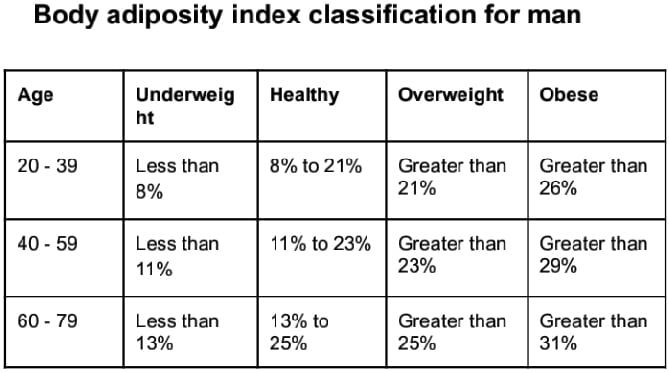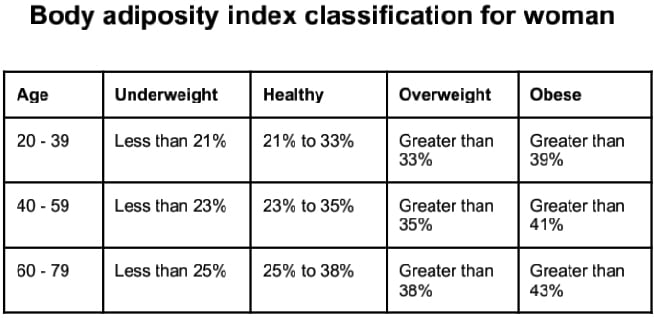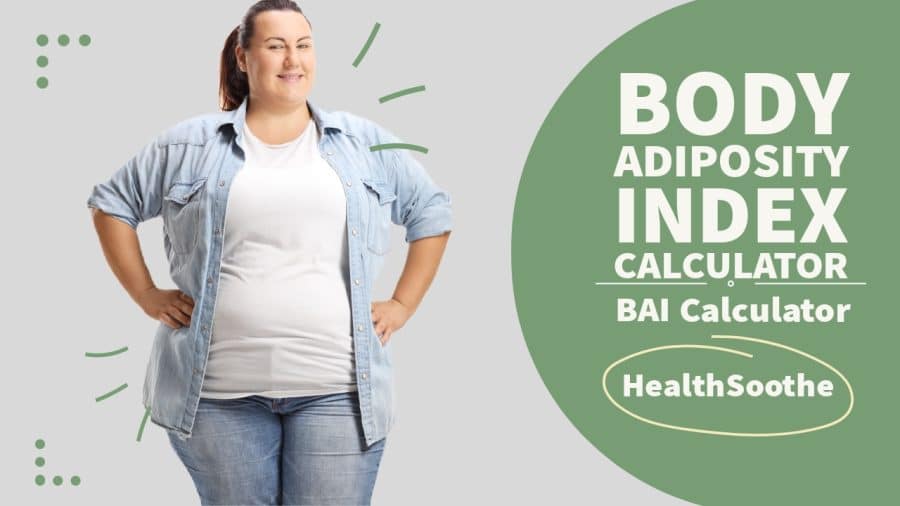Are you curious about the amount of fat in your body? Perhaps you're concerned that you might have an excess of it? Look no further than the Body Adiposity Index calculator, a simple yet powerful tool designed to help you determine your healthy body fat percentage.
The BAI calculator is a unique tool designed to calculate your body adiposity index, which is a measure of the amount of body fat you carry. It takes into account an individual's hip circumference and height as well as other parameters such as gender and age to estimate the body fat percentage, providing a nearly accurate and convenient alternative to other methods such as Body Mass Index (BMI).
With just a few clicks, you can easily assess your body adiposity index and it will identify the classification in which the body fat percentage comes under. You can also refer to the classification chart provided below. This chart offers a range of values indicating whether your BAI falls within a healthy body fat level.
Furthermore, our article will provide you with a comprehensive information on what BAI is, how to calculate your body fat percentage with our online calculator, and some tips for getting the most reliable results.
On our platform, we strive to make our calculators as precise and reliable as possible. However, it's important to note that this tool cannot replace professional medical advice. Therefore, it's always advisable to consult with a qualified medical practitioner for personalised guidance and recommendations.
BIA Calculator
How To Use The BIA Calculator
Using the Body Adiposity Index (BAI) calculator is a simple and straightforward process that requires only a few steps.
Step 1: Gather the necessary measurements which are: your height and your hip circumference either in metric (kilogram, centimetre etc..) or imperial (feet, pound, inches etc..) units. These measurements can be taken with the aid of a measuring tape and with the help of another person.
Step 2: Once you have these measurements, input them into the required field in the BAI calculator along with your gender and age. The unit of these measurements must be either in centimeter or feet.
Step 3: Click on the "Calculate" button once you're done and allow the calculator to work its magic and generate for you an estimated body fat percentage based on the parameters inputted. Your results will be displayed immediately on the screen along with an interpretation of what it means for your overall health.
It's important to note that while BAI can provide an estimate of body fat percentage, it should not be relied on solely, because it may not always be accurate for everyone as it does not take into account other factors such as muscle mass and other body compositions.
Other methods, such as dual-energy X-ray absorptiometry (DXA) or skinfold thickness measurements, may provide more accurate results. Consulting with a healthcare professional or a registered dietitian can help you understand and interpret your body composition measurements more effectively.
What is the Body Adiposity Index?
Body Adiposity Index, or BAI for short, is a relatively new method of determining body fat percentage of an individual. BAI only requires two measurements: height and hip circumference.
The Body Adiposity Index was developed in 2011 by Richard Bergman, PhD at Cedars-Sinai Medical Center in Los Angeles. The goal of the index was to provide an alternative to more complex methods for estimating body fat percentage that require special equipment or expertise.
Unlike BMI, BAI takes into account the distribution of body fat, with particular emphasis on the hip area - known as gluteofemoral adipose tissue. This approach aims to provide a more accurate indication of health risks associated with obesity, particularly those related to cardiovascular disease.
Based on the scientific study conducted by several researchers, the BAI methods of measuring body fat have a comparable level of accuracy to other methods such as BMI, waist circumference or hip circumference. To gain further insight, you can explore our waist to hip ratio calculator.
However, it's important to note that none of these methods, including BAI, provides a highly accurate measure of body fat. They are just primarily utilised for basic testing purposes due to their simplicity and low cost.
How is Body Adiposity Index (BAI) Calculated?
The Body Adiposity Index (BAI) is calculated using a formula that takes into account an individual's hip circumference and height either in centimeter or feet.
The formula for calculating Body Adiposity Index (BAI) is as follows:
BAI = [(hip circumference)/(height^(1.5))] - 18
To calculate the Body Adiposity Index, you will need to measure your hip circumference (in centimeter or feet) at its widest point around the buttocks and then divide it by your height (measured in centimeter or feet) raised to the power of 1.5, then subtract the result by 18. The final resulting value is your Body Adiposity Index (BAI) score, which is used as an estimate of body fat percentage.
It's important to note that BAI is not as accurate as some other methods of measuring body fat, but it can still provide a good estimate. It also has limitations when used with certain populations such as professional athletes or elderly individuals.
While the Body Adiposity Index may not be perfect, it is still a useful tool for estimating body fat percentage without expensive specialised equipment.
Classifications Charts of Body Adiposity Index for Men and Women
Body adiposity index classification man

Body adiposity index classification woman

Tips on Getting Accurate Results from the Body Adiposity Index Calculator
The BAI is used as an alternative and effective method to measure body fat percentage and can be useful for those who may not have access to more advanced equipment.
When it comes to using the Body Adiposity Index (BAI) calculator, there are a few tips that can help ensure you get accurate results;
- Measure your height and hip circumference accurately: To get an accurate BAI calculation, it's important to measure your height and hip circumference correctly. Use a measuring tape to measure the widest part of your hips. Measure your height without shoes and stand up straight against a wall. Repeat the process more than once to ensure that they are accurate.
- Consistency: Try to maintain similar conditions each time you use the BAI calculator for consistent readings because slight differences in posture or clothing can affect accuracy. To ensure better accuracy, measure yourself first thing in the morning before eating or drinking anything – this ensures that there are no fluctuations due to water retention or digestion.
- Don't Solely Rely on BAI Scores: Remember that while the BAI can provide valuable information about your body composition, it shouldn't be relied upon solely. It's important to also incorporate other methods such as BMI and waist circumference into your overall health assessment.
- Consider consulting a healthcare professional: If you're concerned about your body fat percentage or have a history of health issues related to weight, consider consulting a healthcare professional. They can provide more accurate measures of body composition and help you develop a plan to improve your overall health status.
Benefits of Having an Healthy Body Adiposity Index (BAI) Score
Maintaining a healthy Body Adiposity Index (BAI) is crucial for overall health and well-being of an individual. BAI helps to determine the amount of body fat in relation to your height, which can help identify potential health risks.
Here are some of the benefits of having a healthy BAI score:
- Reduced risk of chronic diseases: Excessive body fat, especially visceral fat (fat stored around internal organs), is associated with an increased risk of chronic conditions like cardiovascular disease, type 2 diabetes, and certain types of cancer. By maintaining a healthy BAI score, you can lower your risk of developing these diseases.
- Enhanced physical performance: Excessive body fat can hinder an individual's physical performance, making activities like exercise and sports more difficult. By maintaining a healthy BAI score, you can improve your overall fitness, leading to better performance in physical activities.
- Improved body image and self-esteem: Achieving and maintaining a healthy body composition can improve your body image and boost self-esteem. Feeling confident and satisfied with your physical appearance can have a positive impact on your mental health and overall quality of life.
- Better mobility and joint health: Carrying excess body fat can put additional strain on joints, leading to discomfort and increased risk of joint-related conditions, such as osteoarthritis. By maintaining a healthy BAI score, you can reduce stress on these joints, improve mobility, and lower the probability of having joint problems.
- Long Life Expectancy: Several studies have associated a healthy body composition to longer lifespan. By maintaining a balanced body fat percentage, you may enhance your chances of living a longer and healthier life.
What Can You Do to Improve Your BAI Score?
Improving your Body Adiposity Index (BAI) score is a key part of maintaining good health. The BAI calculator can help you determine where you stand in terms of body fat percentage and overall health, but it's up to you to make changes if necessary.
If you are looking to improve your BAI score, there are several things you can do:
- Increase your physical activity: Regular exercise can help you burn excess calories, reduce body fat, and improve your overall health. Aim for at least 150 minutes of moderate activity per week, such as brisk walking, cycling, or swimming.
- Follow a healthy diet: Eating a balanced diet with plenty of fruits, vegetables, lean proteins and healthy fats can help maintain an optimal weight and reduce body fat while reducing the risk for chronic diseases such as heart disease and diabetes.
- Reduce your alcohol intake: Alcohol contains empty calories and can contribute to weight gain and increased body fat. Limit your alcohol intake to no more than one drink per day for women and two drinks per day for men.
- Get enough sleep: When we don't get enough sleep our bodies tend to produce more ghrelin - the hunger hormone - leading us to overeat or crave unhealthy foods which also in turn leads to weight gain and increased body fat. Aim for at least 7-9 hours of sleep per night to promote a healthy weight and reduce body fat.
- Regulate stress levels: Stress increases cortisol levels which have been linked to increased abdominal fat storage. Techniques like meditation or yoga may be helpful in managing stress levels.
Health Dangers Associated with Very Low or High BAI Scores
Having a very low or high Body Adiposity Index (BAI) score can put your health at risk. If your BAI is too low, it means that you are underweight or have very little body fat which can lead to osteoporosis and other bone-related problems. This is because body fat helps in the absorption of calcium which keeps our bones healthy.
On the other hand, having a high BAI score indicates that you are overweight or have excess body fat which puts you at an increased risk for various chronic diseases such as type 2 diabetes, hypertension, heart disease and stroke. Excess body fat also leads to joint pain, sleep apnea and even certain cancers.
In order to reduce the risks associated with a high or low BAI score, it's recommended that individuals maintain a balanced diet filled with nutrient-dense foods alongside engaging in regular physical activity.
Final Advice
Using our Body Adiposity Index Calculator is an effective way to monitor your body fat percentage. By entering your height and hip circumference measurements into the calculator, you can get a quick estimate of your body fat percentage and determine if you are within a healthy range.
Using this tool regularly can help you track changes in your body composition over time and make adjustments to your diet and exercise routine when needed. Additionally, the convenience of being able to use this calculator from the comfort of your own home makes it an accessible option for anyone looking to improve their overall health.
We really hope you enjoyed this article and we've been able to answer some of your questions. If there's any question you think we haven't touched or you need an answer to, please do let us know in the comments below. Thanks for reading!


